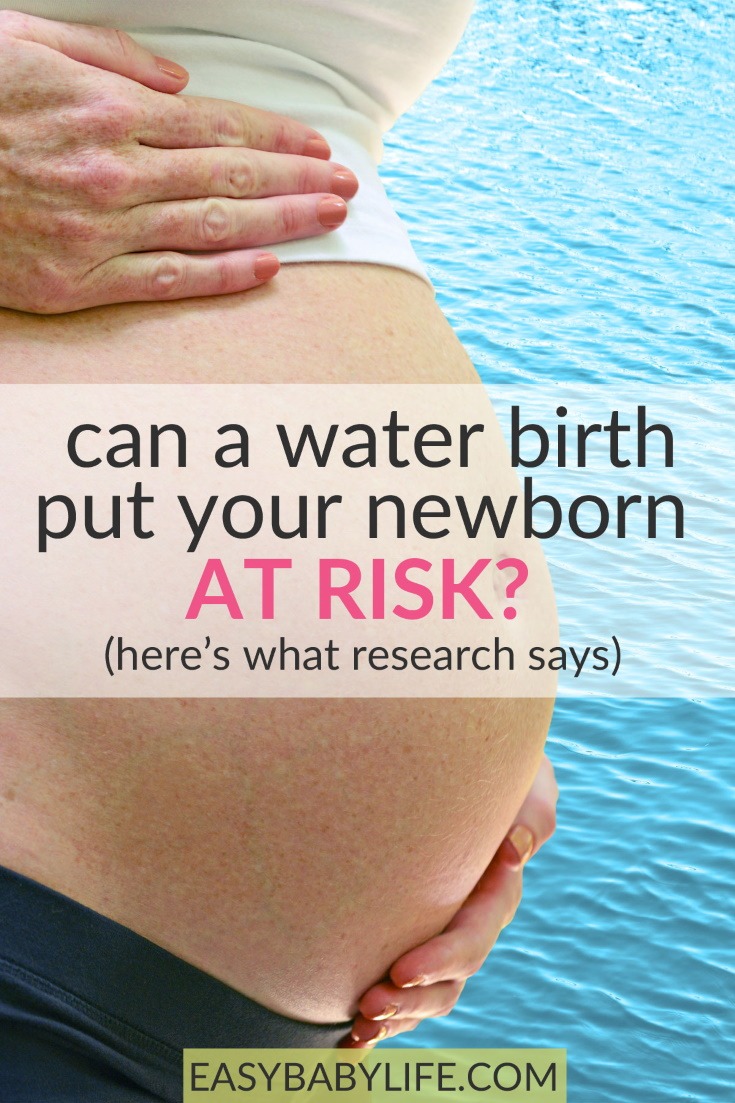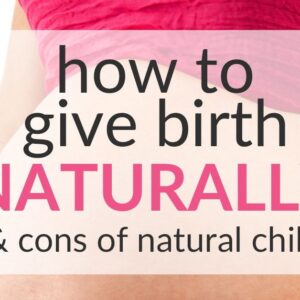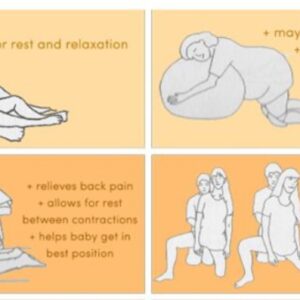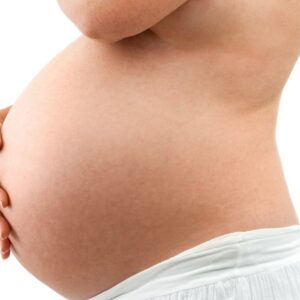
Water births are incredibly popular for a number of reasons, including acting as natural pain relief during active labor, allowing the mother to birth in an easier position, and the suggestion that babies are born more relaxed (very questionable!).
But can a water birth put your newborn baby at risk? What about putting You at risk?
And the big question: Are water births riskier than ‘land’ births?
Natural birthing methods have been explored and encouraged over recent years leading to a massive increase in hypnobirthing, home births and water births across the world. Many hospitals and birthing centers include birthing pools in their delivery suites these days, giving Mom the option of natural water birth.
At the same time, new studies are published from time to time, warning that giving birth in water is unsafe for the baby and even for the mom. And of course, these studies get enough publicity to any pregnant mom uncertain about whether to really go for a water birth or not.
We’ve taken a look at some of the different studies on water birth risks.
Our conclusion: Go ahead with your water birth if you want and you’re healthy. (But read about the studies below first.) You’ll find links to all the research studies below the article.
Get immediate expert help with your pregnancy questions through JustAnswer Pregnancy:A Deep Look: Water Birth Safety Studies
- Drowning Babies
- Infections
- Risks For Mom
- Should I Consider A Water Birth?
- Natural Childbirth Book Tips
Drowning Babies
One of the big questions many Moms-to-be ask when considering a water birth is won’t the baby drown?
It’s a valid question, and it’s one that research doesn’t seem to have a definitive answer to. Take a look at these differing findings below:
Study 1: Breathing Problems After Water Birth
Published in a 2002 edition of Pediatrics, this study looked at 4 cases of newborns being readmitted to hospital in the days and weeks following birth for ‘respiratory distress‘ (that’s breathing problems to you and me) needing medical intervention.
Some also suffered from seizures.
What all 4 cases had in common was that the babies had been born via a water birth and all were eventually diagnosed with water aspiration;
inhalation of water into the lungs which affects breathing and can cause apnea; a condition which causes sufferers to regularly stop breathing – scary stuff.
Study 2: Babies Are Protected By Diving Reflex
In contrast, a much larger study published in Fetal Diagnosis & Therapy looked at over 2000 water births and reported that there was no instances of water aspiration and that no neonate has ever drowned or died after birth as a result of a waterbirth.
The study actually makes a very good point: for 9 months, babies live in a bubble of amniotic fluid. Towards the end of pregnancy, when lung capacity matures, babies start to practice their breathing, so they’re in a situation where they’ve got their mouths open and they’re surrounded by water, much like what happens during a water birth. And yet, they don’t drown inside the uterus.
In the uterus, the babies get their oxygen through the umbilical cord. The cord is not cut until the baby is out of the water, so drowning really isn’t a possibility at all. However, inhaling water is possible, which in itself can certainly be harmful to the baby.
There are indications, though, that the diving reflex that babies develop is preventing inhalation of water as opposed to amniotic fluid.
This reflex is incredibly strong in children up until around 9 months of age. The study concludes that “this diving reflex is responsible for the inhibition of water aspiration in utero as well as during birth in water”.
Infections
It goes without saying that infections are possible in newborns if they are delivered in less than ideal circumstances; an unprepared home or an
unsterilized hospital bed for example. The risk of infection in these situations is there whether a child is born via water birth or land birth.
Studies have reported cases of infection in newborns born underwater, particularly pneumonia, including one study that reported a case of
Legionella pneumonia in a one-week-old water birth infant.
All cases of severe infection in water birth babies have been caused by contaminated water or heating equipment, so it appears that as long as a water birth is carried out in a clean and reputable setting, there should be no more risk of infection than is present with a traditional birth.
A 2004 study comparing infection rates between land births and water births found that there was no significant difference in either infant or maternal infections between the groups, and an early study in the UK confirmed that ‘the theoretical increased risk of maternal and neonatal infection is not
supported’.
Risks For Mom
Infections are less likely for Mom than baby, and the real proposed risk for Moms choosing to give birth in watre, is generally perineal tears and trauma leading to blood loss.
But is this truly a risk? Once again, science is undecided. Let’s take a look at two differing findings.
Study 1: More Perineal Tearing
A 2004 study comparing results of water births and land births found that perineal tears and trauma were much more common in water births, with 5% reporting vaginal tearing, 18% with a 1st-degree tear, 20% with a 2nd-degree tear and 3% with a 3rd-degree tear. Findings for land births showed these figures to be 0%, 10%, 15% and 0% respectively.
Interestingly, the study shows a higher number of episiotomies performed
on land birth Mothers, possibly because the perineum is much harder to
access during a water birth, so this is one reason why tears have been found to be more common in water births.
Another reason is that, during a traditional birth, laboring Moms are often advised to stop pushing as the head is emerging. This allows the vagina to stretch slowly to accommodate the head.
When giving birth in water, it is far more difficult for midwives to pinpoint this moment, and babies are sometimes born very quickly, causing far more trauma to the area.
Study 2: Less And Less Severe Perineal Tearing
However, a further study which also showed fewer episiotomies during water births concluded a significant reduction in perineal trauma, especially 3rd and 4th-degree tears, during this type of labors.
It is argued that immersion in warm water softens and relaxes the vagina, causing it to stretch more easily during the birth, rather than tearing.
Should I Consider A Water Birth?
If that’s what you want, then absolutely. Much more research and many more conclusive findings are needed before we can definitely say with all certainty that water births are riskier than land births. If you would like to give birth in water, then go for it. Just be sure to read up on the risks so you can make an informed decision.
Look at it this way: If there was a real increased risk of water birth over land birth, hospitals and birthing centers would not encourage the method. Rules of how we should be looking after our children (think about weaning or sleeping guidelines) are changing constantly as more research is being carried out – the moment something is proven to have a detrimental effect, the rules change.
And I’m sure that will be the same for birthing techniques.
Until we have definitive proof of the dangers of water births, they should be considered a safe and enjoyable method of natural birthing.
To see a woman giving birth in water, have a look at these waterbirth videos.
And here is a natural water birth story, shared by one of our lovely readers.
Book tips for natural childbirth
There are many excellent books and courses to learn about giving birth
naturally. The following books are highly recommended:
- The Mama Natural Week-by-Week guide to Pregnancy and Childbirth
- Natural Childbirth the Bradley Way
- Adventures in Natural Childbirth: Tales from Women on the Joys, Fears, Pleasures, and Pains of Giving Birth Naturally
- Pregnancy, CHildbirth and the Newborn
- The Essential Homebirth Guide
More On Natural Child Birth
References
- Water Birth: A Near-Drowning Experience (Pediatrics)
- Underwater Birth: Missing the Evidence or Missing the Point? (Pediatrics)
- Waterbirths: A comparative study
- Legionella pneumophila Pneumonia in a Newborn after Water Birth: A New Mode of Transmission
- A retrospective comparison of waterbirths and conventional vaginal deliveries
- Water birth: microbiological colonisation of the newborn, neonatal and maternal infection rate in comparison to conventional bed deliveries
- A pilot study for a randomised controlled trial of waterbirth versus land birth

Paula Dennholt founded Easy Baby Life in 2006 and has been a passionate parenting and pregnancy writer since then. Her parenting approach and writing are based on studies in cognitive-behavioral models and therapy for children and her experience as a mother and stepmother. Life as a parent has convinced her of how crucial it is to put relationships before rules. She strongly believes in positive parenting and a science-based approach.
Paula cooperates with a team of pediatricians who assist in reviewing and writing articles.






